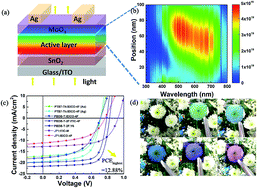Interfacial engineering and optical coupling for multicolored semitransparent inverted organic photovoltaics with a record efficiency of over 12%†
Abstract
Semitransparent organic solar cells (ST-OSCs) exhibit great potential in building-integrated photovoltaics (BIPV) due to their low cost large area manufacturing process manufacturing process and tunable vivid colors for power-generating glass. However, the contradiction of achieving high power conversion efficiency (PCE) whilst keeping rational average visible transmittance (AVT) leads to the development of ST-OSCs lagging behind that of traditional opaque OSCs. In this work, chemically precipitated SnO2 colloidal particles are used as an electron collection interlayer in ST-OSCs for the first time. Due to the excellent transparency and high reflective index, the SnO2 layer can effectively tune the light-distribution of the incident light within the whole multilayered ST-OSCs. Guided by finite-difference time-domain (FDTD) and optical transfer matrix formalism (TMF) simulation, we successfully solved the contradiction between PCE and AVT, and achieved multicolored ST-OSCs with record high efficiency. The deep blue device shows the highest PCE of 12.88%, AVT of 25.60% (from 370 nm to 740 nm) and color rendering index (CRI) of 97.6, which are the best values for the state-of-the-art ST-OSCs. Our findings indicate that interfacial engineering and optical coupling are effective approaches to achieve high performance ST-OSCs with vivid colors, remarkable transparency and high efficiency.



 Please wait while we load your content...
Please wait while we load your content...